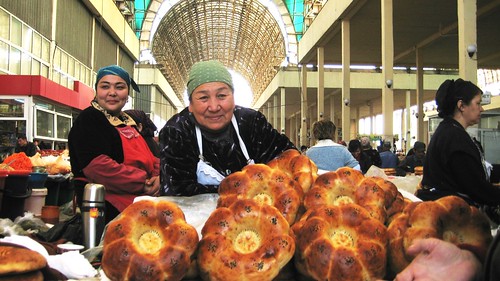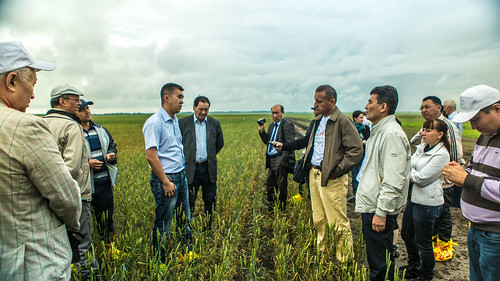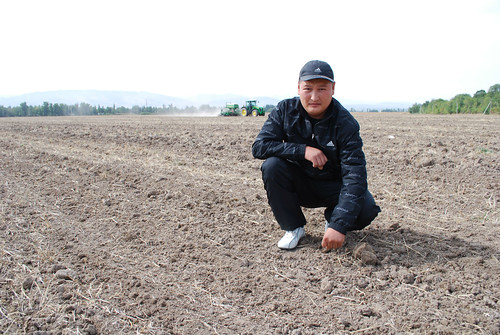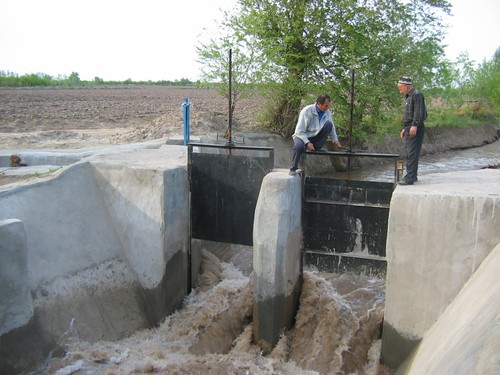A Women Farmers’ Cooperative on a Mission to Decrease Hunger
In Nigeria, one woman is leading her community to use sustainable farming methods, as well as technology, to thrive. A group of women farmers in Nigeria play a pivotal role…
Read MoreIn countries where the vast majority of the rural poor depend on agriculture for their livelihoods, the effects of climate change are often most immediately felt and can be devastating. Central Asia is no exception: more extreme temperatures, erratic precipitation, more frequent droughts and other threats are all becoming increasingly common experiences among smallholder farmers, yet local awareness and action on climate change in the region has lagged behind. From wheat farming to water management, the U.S. Government is supporting climate smart agriculture and the sustainable use of natural resources in the Central Asian Republics to help ensure that farmers will be able to feed their families for a long time to come.

Selling food at a marketplace in Tajikistan, where bread accounts for half of people’s daily calories on average. Photo by USAID.
Bread, the lifeblood of the Central Asian diet, provides 50 percent or more of average daily caloric intake in Tajikistan. Much of the wheat consumed in Tajikistan is imported from Kazakhstan. A regional wheat resiliency project, funded through the Global Climate Change Initiative, is currently testing drought-resistant varieties of wheat, different sowing times and soil tilling techniques in Tajikistan to help smallholder farmers overcome challenges to production.

Demonstrating adaptive agricultural technologies for wheat in Kazakhstan’s Kostani region. Photo by UNDP.
As weather becomes more unpredictable and extreme in Kazakhstan’s wheat regions, climate information services that enable farmers, processors and policymakers to take proactive measures are essential to lessen the negative impacts of this increasing variability.
Last year, a new climate change mitigation program managed by the U.S. Agency for International Development (USAID) was also launched to help Kazakhstan achieve long-term sustained reductions in greenhouse gas emissions intensity. In addition to working closely with the private sector and Government of Kazakhstan to implement smart policies, the program is providing specialized training to help build the next generation of climate and energy professionals in Kazakhstan.

With USAID assistance, Kanybek Imankulov, a father of four in Kyrgyzstan, applied environmentally friendly no-till technology to his land using modern agricultural machinery. He says this change has increased his income and improved the living standards of his family. Photo by IFDC.
Scaling up agricultural technologies to smallholder farmers in a sustainable way means utilizing approaches that will conserve natural land and water resources. That’s why Feed the Future promotes improved agricultural management practices like no-till technology, which preserves land from mechanical erosion, enhances soil quality, reduces the use of fertilizer and increases water infiltration into the soil. The practice is good for farmers as well as for the soil, as it increases crop productivity and considerably reduces farmer expenditures for fuel, planting and other field operations.

Members of a water users association in Tajikistan’s Khatlon province build a water gate to improve irrigation flow control to reduce water losses and improve irrigation efficiency. Photo by USAID.
Water scarcity is one of the most pressing development challenges of the early 21st century, and more than 70 percent of global water use occurs in the food value chain. As the world population continues to grow, agriculture will need to use water more efficiently to feed nine billion people by 2050.
In landlocked Tajikistan, rainfall is very limited and more than two thirds of the country’s arable land requires irrigation in order to be cultivated by farmers. Efficient irrigation management is one component of broader natural resource conservation and resilience in the face of Tajikistan’s receding glaciers, varied rainfall and reduced snow pack. To help farmers sustainably build and maintain irrigation systems that underpin growth in Tajikistan’s agriculture sector, Feed the Future has helped to establish and support 60 community-based water users associations, groups of farmers who work together to plan how the community will deliver water to its crops. These groups cover over 120,000 hectares of irrigated farm land, where farmers are enjoying better yields and increased incomes.
Watch a video about water access and food security in Tajikistan.
In Nigeria, one woman is leading her community to use sustainable farming methods, as well as technology, to thrive. A group of women farmers in Nigeria play a pivotal role…
Read MorePhoto Credit: West Africa Trade and Investment Hub February 24 marks the grim second anniversary of Russia’s invasion of Ukraine. The invasion not only brought suffering to millions of Ukrainians,…
Read MoreSource: USAID On this year’s International Day of Women and Girls in Science, learn about the contributions and challenges these researchers face Every year, International Day of Women and Girls…
Read MoreWomen have always worked in agrifood systems, but these systems have not always worked for women. That’s because barriers have stood in their way, preventing them from making their fullest contributions. Last year, the UN Food and Agriculture Organization’s (FAO) “Status of Women in Agrifood Systems” report showed us just how slow progress has been in closing the gender gap in agriculture over the past decade. Their access to irrigation, livestock, land ownership and extension services has barely budged over the past decade. Also, they are facing these challenges at a time of immense global shocks.
Read More